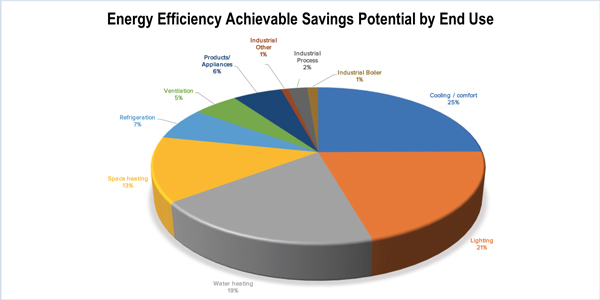By Rich Heidorn Jr.
The New York State Energy Research and Development Authority (NYSERDA) published a white paper Thursday outlining plans to accelerate the state’s energy efficiency (EE) goal by 40%.
The paper calls for 185 trillion British thermal units (TBtu) of cumulative annual site energy savings relative to forecasted 2025 consumption. The agency said that would deliver almost one-third of the emissions reductions needed to meet the state’s goal of reducing greenhouse gas emissions 40% from 1990 levels by 2030.
NYSERDA said this would include a 30,000-GWh reduction from forecasted 2025 electricity sales — a 3% reduction in investor-owned utility sales in 2025 and average savings exceeding 2% of IOU sales between 2019 and 2025.
The new target is based on savings in buildings and the industrial sector across all fuel sources (electricity, natural gas, heating oil and propane).
“This paper proposes a portfolio of accelerated actions to drive an additional 41 TBtu of aggregate efficiency savings statewide by 2025 or a 40% increase above the state’s current commitments for the 2019–2025 period,” NYSERDA said.
NYSERDA said it will spend an additional $36.5 million to train more than 19,500 people for energy efficiency and other “clean energy” jobs.
“The path to delivering on New York’s 2025 energy efficiency target recognizes that a mix of strategies will be necessary, focusing on the approaches best suited for specific markets and their needs and on the mix best suited for long-term cost-effectiveness,” the report said. “The portfolio will include a good measure of innovation, testing those approaches with the best promise, then scaling those that take hold.”
NYSERDA said it will seek to meet the 2025 target by:
- “Accelerating and shifting” utility energy efficiency programs by increasing market-based EE, more leverage of public funds and more effective programs. “This includes the proposed development of a shared savings approach that provides greater opportunity and reward for utilities to advance energy efficiency as a business and as a resource.” (See NY Fine-tuning CES; Phasing out EE Program.)
- Dedicating at least 20% of any additional public investment in EE to low- to moderate-income consumers.
- Strengthening laws on building codes and appliance standards by increasing EE requirements.
- “Driving deep energy savings” through building retrofits and construction and cost-effective heat pump adoption. “If New York is to achieve the 40 by 30 … climate goals, it will be essential to retrofit the state’s existing building stock to dramatically reduce energy consumption, so that most buildings are able to reach passive house or net zero energy performance levels. This presents an imperative to develop deep (i.e., 30-40-50% energy savings) and replicable retrofit strategies … In the absence of government mandates, [efficient construction practices] will only reach true scale when market players view them as sound financial investments.” (See Lovins: We’re Only Scratching the Surface on Energy Efficiency.)
- Leading by example with EE in state facilities.
The agency noted the state’s 2015 energy plan identified lighting as one of the biggest EE opportunities.
“Since then, utilities’ efficiency programs have focused heavily on lighting. At the same time, costs of high-efficiency lighting products have come down and natural adoption [has] increased, resulting in a greater portion of the lighting savings potential being achieved in the years since this study was published as compared to other end uses.
“However, this data shows several other high-potential, end-use opportunities in addition to lighting — specifically, cooling and water heating. This highlights a need to broaden the scope of utility programs to address other cost-effective efficiency measures and to encourage approaches that pair lower-cost opportunities like lighting with other efficiency improvements to achieve deeper savings.”
The state Public Service Commission will take steps to implement the white paper, beginning with a technical conference.
“Following the initial technical conference, DPS Staff will initiate and define a process and schedule supporting further development of the jurisdictional aspects of the white paper,” NYSERDA said. “This is expected to include additional technical conferences, as well as topical working groups and a formal written stakeholder comment process with the goal of developing an adequate record for commission action, including benefit, cost, and practical implementation information.”




